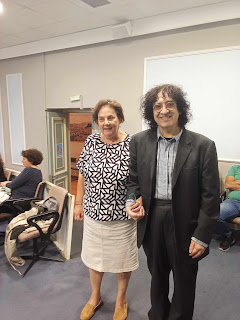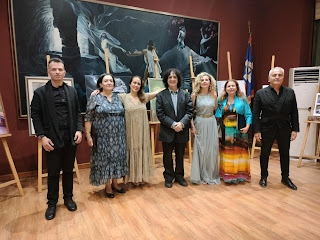The Federation of Hellenic Societies of Greater New York
To promote cultural ties between the United States of America and Greece through Music and the Arts.
Τετάρτη 23 Οκτωβρίου 2024
The Federation of Hellenic Societies of Greater New York Commemorates October 28, 1940 OXI DAY
The Federation of Hellenic Societies of Greater New York
Κυριακή 20 Οκτωβρίου 2024
The World Philosophical Forum presented works by the internationally renowned composer Panagiotis Karousos at the Spiritual Center of the Municipality of Athens
The World Philosophical Forum presented works by the internationally renowned composer Panagiotis Karousos at the Spiritual Center of the Municipality of Athens
Friday, October 18, 2024. A concert by the internationally renowned music composer Panagiotis Karousos was presented with great success at the World Philosophical Forum.
"ANTONIS TRITSIS" Amphitheater, Spiritual Center of the Municipality of Athens.
The distinguished composer Panagiotis Karousos was congratulated by Eleni Zontirou, Municipal Councilor of the Municipality of Athens and President of the Culture, Sports and Youth Organization of the Municipality of Athens (OPANDA).
Poems set to music by music composer Panagiotis Karousos, Parthenon (Kostis Palamas), Karyatides (Ioannis Polemis), Spring Symphony (Yiannis Ritsos) performed by soprano Rhea Voudouris, and the choral "Prometheus we are friends" from the opera "Prometheus Bound" were presented. The concert opened with a song dedicated to Mimi Plessas, "A sky with stars" performed by tenor Yiannis Darrios.
Artistic program: Presentation of works by the internationally renowned music composer Panagiotis Karousos by the "Rhapsodes" Choir and lyrical soloists. Rea Voudouri (soprano), Giorgos Keramidaris (tenor), Yiannis Darreios (tenor), Foteini Papachristou (alto), Niki Zacharopoulou (alto), Maria Grigoriou (alto), Argyris Kontonikolaou (tenor). Piano: Christiana Manou. Panagiotis Karousos, music composer. The artistic program was well liked and warmly applauded by the select audience.
14th International Symposium of Classical-Practical Philosophy of the Greek Central Sector of the P.F.F. Symposium Topic: "The contribution of practical philosophy to the development of a sense of global responsibility in relation to major international problems"
Greeting: Andreas Renzoulas, Ambassador of Greece to the World Organization for Cultural Diplomacy. Ioannis Galanis, member of the Board of Directors of WPF and General Director of EN.P.AN. (Culture and Development Associations).
Με μεγάλη επιτυχία παρουσιάστηκε συναυλία του διεθνούς φήμης μουσικοσυνθέτη Παναγιώτη Καρούσου στο Παγκόσμιο Φιλοσοφικό Φόρουμ
Το Παγκόσμιο Φιλοσοφικό Φόρουμ παρουσίασε έργα Παναγιώτη Καρούσου στο Πνευματικό Κέντρο Δήμου Αθηναίων
Παρασκευή 18 Οκτωβρίου 2024. Με μεγάλη επιτυχία παρουσιάστηκε συναυλία του διεθνούς φήμης μουσικοσυνθέτη Παναγιώτη Καρούσου στο Παγκόσμιο Φιλοσοφικό Φόρουμ.
Αμφιθέατρο “ΑΝΤΩΝΗΣ ΤΡΙΤΣΗΣ”, Πνευματικό Κέντρο Δήμου Αθηναίων.Τον διακεκριμένο συνθέτη Παναγιώτη Καρούσο συνεχάρη η Ελένη Ζωντήρου Δημοτική Σύμβουλος του Δήμου Αθηναίων και Πρόεδρος του Οργανισμού Πολιτισμού, Αθλητισμού και Νεολαίας του Δήμου Αθηναίων (ΟΠΑΝΔΑ).
Παρουσιάστηκαν μελοποιημένα ποιήματα από τον μουσικοσυνθέτη Παναγιώτη Καρούσο, Παρθενών (Κωστής Παλαμάς), Καρυάτιδες (Ιωάννης Πολέμης), Εαρινή Συμφωνία (Γιάννης Ρίτσος) ερμηνευμένο από την σοπράνο Ρέα Βουδούρη, και το χορωδιακό «Προμηθέα είμαστε φίλοι» από την όπερα Προμηθέας Δεσμώτης. Η συναυλία άνοιξε με ένα τραγούδι αφιερωμένο στον Μίμη Πλέσσα, "Ένας ουρανός μ’αστέρια" ερμηνευμένο από τον τενόρο Γιάννη Δάρρειο.
Καλλιτεχνικό πρόγραμμα: Παρουσίαση έργων του διεθνούς φήμης μουσικοσυνθέτη Παναγιώτη Καρούσου από την Χορωδία «Ραψωδοί» και σολίστ λυρικού τραγουδιού. Ρέα Βουδούρη (σοπράνο), Γιώργος Κεραμιδάρης (τενόρος), Γιάννης Δάρρειος (τενόρος), Φωτεινή Παπαχρήστου (άλτο), Νίκη Ζαχαροπούλου (άλτο), Μαρία Γρηγορίου (άλτο), Αργύρης Κοντονικολάου (τενόρος). Πιάνο: Χριστιάνα Μάνου. Παναγιώτης Καρούσος, μουσικοσυνθέτης. Το καλλιτεχνικό πρόγραμμα άρεσε πολύ και καταχειροκροτήθηκε θερμά από το εκλεκτό κοινό.
14ο Διεθνές Συμπόσιο Κλασικής-Πρακτικής Φιλοσοφίας του Ελληνικού Κεντρικού Τομέα του Π.Φ.Φ. Θέμα Συμποσίου: «Η συμβολή της πρακτικής φιλοσοφίας στην ανάπτυξη αισθήματος παγκόσμιας ευθύνης σε σχέση με τα μείζονα διεθνή προβλήματα»
Χαιρετισμός: Ανδρέας Ρεντζούλας, Πρέσβης της Ελλάδας στον Παγκόσμιο Οργανισμό Πολιτιστικής Διπλωματίας. Ιωάννης Γαλάνης, μέλος Δ.Σ του WPF και Γ. Διευθυντής των ΕΝ.Π.ΑΝ. (Ενώσεις Πολιτισμού και Ανάπτυξης).
Haḍḍa (Παστό: هډه) ελληνοβουδιστικός αρχαιολογικός χώρος
Haḍḍa (Παστό: هډه) είναι ένας ελληνοβουδιστικός αρχαιολογικός χώρος που βρίσκεται δέκα χιλιόμετρα νότια της πόλης Τζαλαλαμπάντ, στην επαρχία Νανγκαρχάρ στο ανατολικό Αφγανιστάν.
Oratorio « La Lumière du Christianisme » de Panagiotis Carousos
Le lundi 15 décembre 2025, un concert du compositeur de renommée internationale Panagiotis Carousos, intitulé « La Lumière du christianisme...

-
Panagis -or Panais- Koutalianos was born in Koutali (Ekinlik) in the sea of Marmara, (modern day Turkey) in 1847. He was a handsome man of...
-
Minoan ”Master’s Seal” (1450-1400 BC); from Chania, Crete, Greece. The seal impression was found at Chania and depicts a young, heroic fig...
-
The Sumerian "handbags," often depicted in ancient Mesopotamian reliefs, have intrigued scholars and enthusiasts alike due to th...




















































